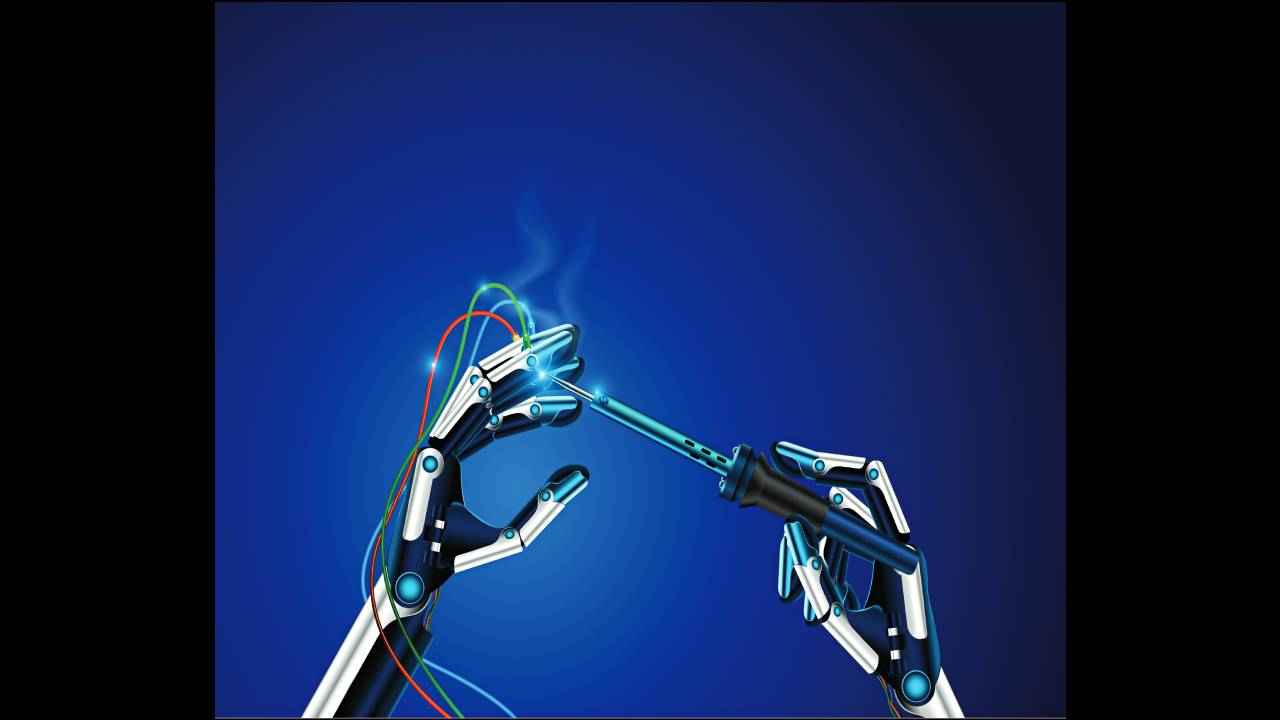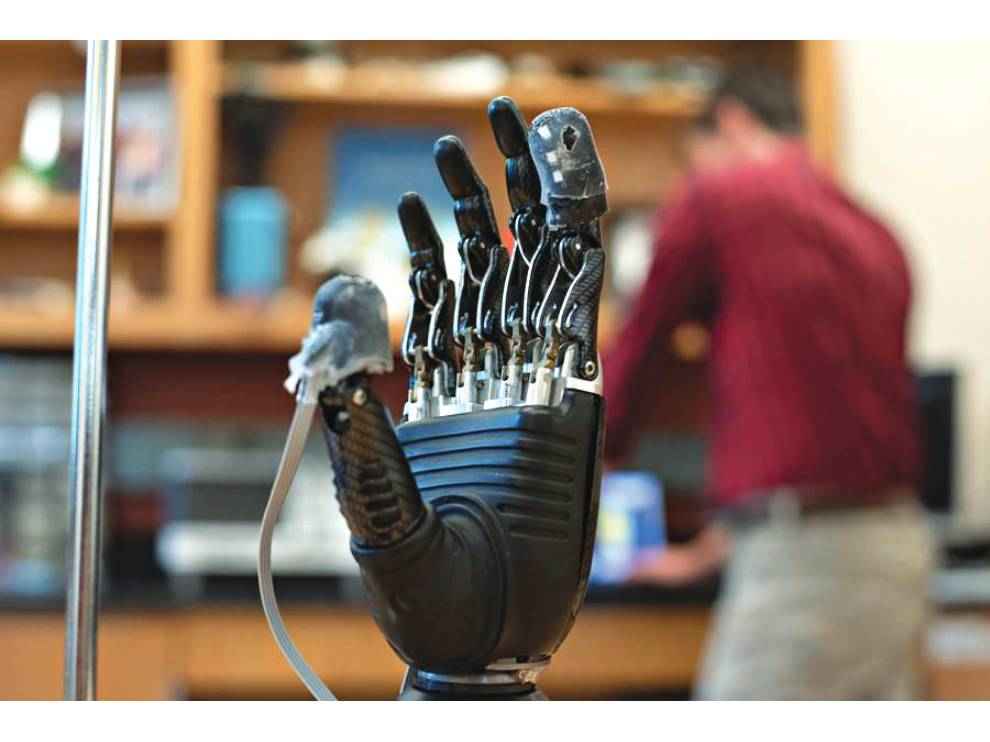Artificial nerves are allowing robot brains to get tactile feedback

Human limbs provide a tremendous amount of continuous sensory feedback to the human brain. These include the sensation of touch, pressure, heat, orientation and pain. It is this information that allows humans to effectively handle a water balloon, take their fingers away from a shard of glass, feel a pin prick or reflexively pull away fingers from a hot surface such as a toaster or a stove. It is the nervous system, along with the muscles residing in the limbs that provide all these sensations. However, robots and those with prosthetic limbs, do not enjoy the benefits of being able to feel. Scientists in many universities around the world are coming up with innovative ways to address this problem.
 Survey
SurveyAll over the skin, are specialised nerve endings known as mechanoreceptors. When a force is applied on these receptors, they change their voltage. The changes in voltage from a number of mechanoreceptors are relayed by neurons. This feeling passes through the spinal cord to the human brain. The amount of pressure is determined by the frequency of the electric pulses, or hertz. A higher frequency indicates a higher amount of pressure. Artificial sensory nerves are designed along similar lines. Piezoelectric receptors convert mechanical stress into electricity. The more pressure is applied, the more electricity is generated. This electricity is passed on to ring oscillators, that generate electrical pulses based on the input voltage. A higher pressure on the receptors means a higher frequency of electric pulses, similar to the neurons in the human body. Another device known as the synaptic transistor converts the inputs from multiple ring oscillators. This artificial nervous system developed by researchers at Stanford and Seoul National University can one day be used to restore a sense of touch to amputees, and provide one to robots. The applications of this invention for soft, modular, medical, educational and evolutionary robotics are particularly promising.
One of the senior researchers on the project, Zhenan Bao says, “we take skin for granted but it’s a complex sensing, signaling and decision-making system. This artificial sensory nerve system is a step toward making skin-like sensory neural networks for all sorts of applications.”
The artificial sensory nerve circuit has a total of three components, a touch sensor that can detect even minute forces, a flexible electronic neron, and an artificial synaptic transistor. Tae-Woo Lee, from Seoul National University who designed the artificial synaptic transistor says, “Biological synapses can relay signals, and also store information to make simple decisions. The synaptic transistor performs these functions in the artificial nerve circuit.”
The system is sensitive enough to detect braille, but there remains a lot of work to be done. Currently, this artificial nervous system cannot detect heat or other sensations. Remaining challenges include designing the system using flexible circuits, and to find a way to make it interface with the brain. The team is also looking into low-powered sensory nets for robots, to give them sense perception similar to the human skin. The same system can also be used to simulate reflexes, such as the “knee-jerk” reaction. When the knee is tapped, there is an instant reaction of stretching the leg muscles. When the synaptic network detects the stretch, it sends two signals. One, is to contract the leg muscles again, and another to the brain to inform it that the muscle had been stretched. The reflex action occurs even before the brain comes to know that there is a requirement for a reaction, without conscious thought. These reflexes play a role in the safety of the body, and providing such reflexes to prosthetics as well as robots can serve the same functions.
One of the problems with prosthetic limbs is that amputees have to depend on sight to understand the position and orientation of the limb. They cannot really feel it, like people do with natural limbs, or understand how much pressure is being applied. Around 20 per cent of prosthetic limbs are rejected, which is a pretty high number. Researchers from MIT have devised a method that allows amputees to feel the position, orientation and forces on prosthetic limbs. Such information is normally conveyed by muscles, which relay it to neurons. These neurons remain in place even after the limbs are amputated, which was used by researchers at MIT.
The approach currently requires surgery for grafting a pair of muscles from elsewhere in the body, to the site of the amputation. These muscles exist in agonist-antagonist pairs in the human body, where one muscle contracts while the other expands. For example, when the biceps are contracted, the triceps expand. The team described their findings in a study on rats, and hope to move on to human subjects. Hugh Herr, senior author of the study says, “if you were to give a prosthetic-arm user a barbell to hold, they would actually feel the torque on the prosthetic wrist joint”.
Researchers at Johns Hopkins University have created something called the e-dermins, which is an electronic skin loaded with sensors that mimic the nerves in humans. The material can be layered onto conventional prosthetics, to return a sense of touch to the humans, who can then control the prosthetics better. There are receptors for both touch and pain on the skin, which are then relayed to the peripheral nerves of amputees. The stimulation to the nerve endings are non invasive, so there is no surgery required. The e-dermis uses a neuromorphic model which closely tracks the receptors in the human nervous system. One of the amputee volunteers for the researchers, said “after many years, I felt my hand, as if a hollow shell got filled with life again”. The researchers hope to restore tactile sensations to prosthetics devices already in use. The technology has other applications as well, such as gloves for astronauts.
Researchers from Leibniz University described a project to make robots feel pain at the IEEE International Conference on Robotics and Automation (ICRA) in Sweden, in May this year. This might seem like a ridiculous idea, why would one deliberately give machines the ability to feel something unpleasant? Pain actually serves an important function in humans. There is a very rare condition known as congenital analgesia, which fortunately only has 20 recorded cases so far. Humans with this rare disease, cannot feel pain at all, and this leads to an accumulation of bruises, burns and broken bones. Young children especially may not be aware that they are suffering, and can even bite off portions of their own tongues. Pain serves a function in the human body, and informs the brain to move appendages away from hot or sharp objects. Robots, especially the ones of the future that are expected to function in households, public spaces and hospitals may need to feel pain for the same reasons that humans do. By detecting damage, robots can prevent accidents further down the line. The ability to feel pain can allow robots to minimise the damage to themselves, as well as the humans that they are working with.
Aditya Madanapalle
Aditya Madanapalle, has studied journalism, multimedia technologies and ancient runes, used to make the covermount DVDs when they were still a thing, but now focuses on the science stories and features. View Full Profile
